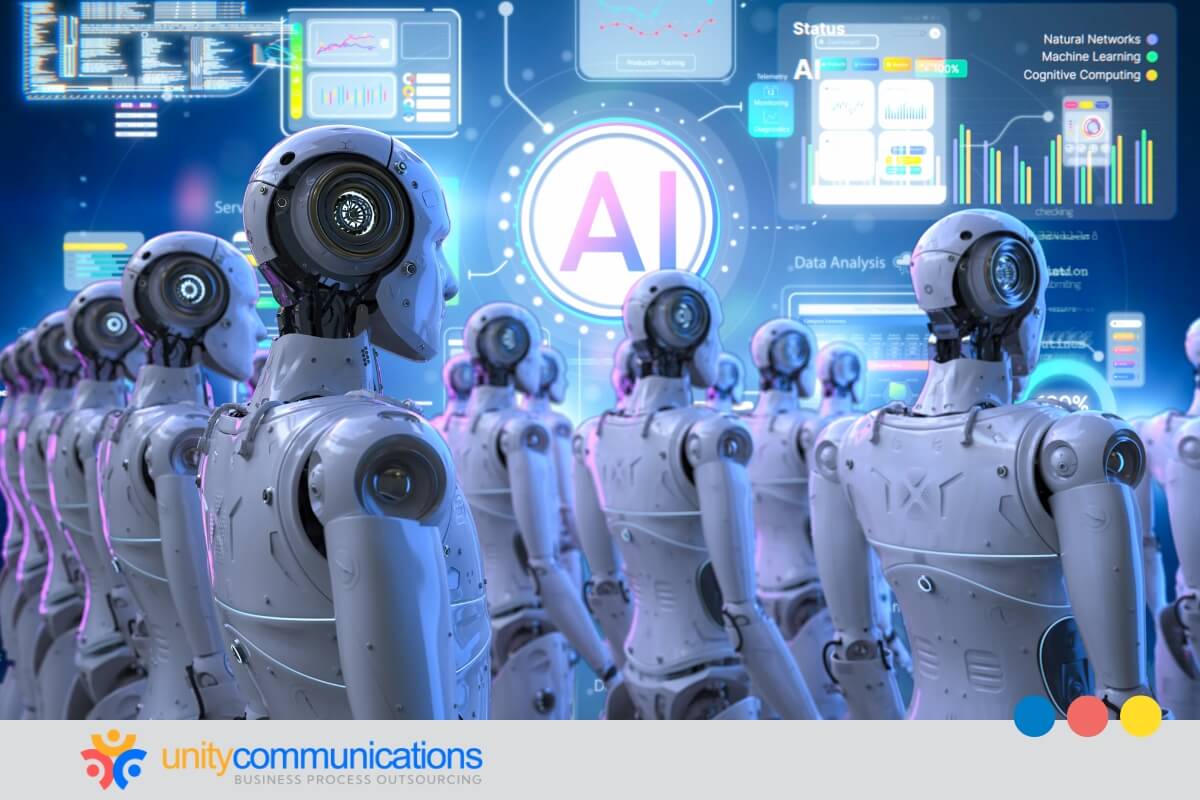Table of Contents
Generative AI (genAI) models are transforming the operations of small- and medium-sized businesses (SMBs) by turning complex data into practical outputs for everyday tasks. Paired with business process outsourcing (BPO), AI makes scaling easier and more cost-effective.
SMBs are already seeing measurable impact. GenAI drives efficiency, boosts customer engagement, and cuts costs while freeing teams to focus on growth.
This guide reveals exactly how genAI models deliver measurable business impact in 2025 and why the timing has never been better for SMB adoption.
What are generative AI models, and what do they mean for SMBs?

For SMBs, the rapid rise of AI agent solutions can feel overwhelming. Yet one area you cannot overlook is genAI models. They are no longer limited to large enterprises but are now practical tools for driving efficiency and growth in smaller organizations.
Think of them as systems that learn from massive amounts of data and generate new content that looks and feels original. Instead of you or your team writing entire reports, analyzing contracts, or drafting campaigns, these tools can handle it in minutes with strong accuracy.
Beyond text, they can generate visuals, code, and even product mockups. For SMB leaders evaluating outsourcing, the connection to what BPO is becomes relevant.
This strategy has long helped companies cut costs and boost efficiency. Pairing BPO services with AI adoption introduces a fresh way to scale without overstretching internal resources.
Key concepts every business leader should understand
Adoption of this technology is spreading quickly. In 2024, 71% of organizations already applied generative AI in at least one business function, compared to only 33% in 2023. This growth highlights how the technology is shifting from pilot projects to real operations.
For SMBs, key points to understand include:
- It can generate text, images, video, and audio content.
- It draws from vast training datasets to provide context-rich outputs.
- It is increasingly embedded in tools you can already use for marketing, human resources (HR), information technology (IT), or finance.
- Adoption spans industries from retail to healthcare, and is not limited to tech companies.
This context shows why decision-makers like you need to pay attention.
How generative AI can drive growth for SMBs
Recent surveys highlight tangible gains. About 82% of small businesses using AI reported workforce expansion in the past year, showing that the technology often supports business growth rather than replacing jobs. For owners and executives, this means opportunity.
Ways it can drive growth for your business include:
- Automate repetitive customer service tasks and free staff for higher-value work.
- Enhance marketing campaigns with personalized, data-driven content.
- Support financial reporting and bookkeeping tasks with faster processing.
- Strengthen outsourced services with AI-powered efficiencies.
- Improve product design through AI-driven prototyping.
SMBs can leverage AI as a growth multiplier by looking at internal processes and outsourced support.
How did generative AI reach today’s level of progress?
Generative AI reached its current level through years of steady innovation, improved computing power, and broader data accessibility. What once felt limited to research labs currently powers daily tools for organizations.
This history matters for SMBs because it shows why adoption is now practical and cost-effective. Major algorithm breakthroughs, training approaches, and infrastructure shaped the foundations supporting today’s generative AI models.
Each leap reduced complexity and lowered the barriers to entry, opening opportunities for businesses that once considered advanced AI out of reach.
Major technological milestones shaping AI development
Some of the defining milestones that paved the way include:
- 2013: Introduction of variational autoencoders, enabling flexible generation of new data samples beyond simple reconstructions
- 2014: Launch of generative adversarial networks (GANs), allowing systems to produce more realistic images and media
- 2015: Development of deep convolutional GANs, improving image-generation stability and realism for practical applications
- 2017: Arrival of transformer models, driving breakthroughs in natural language processing and multimodal AI
- 2020: Advancement of diffusion models, delivering higher-quality image and media generation with fewer artifacts
- 2022: Release of OpenAI’s ChatGPT, bringing large-scale public adoption of conversational generative AI
- 2023: Rapid integration of multimodal AI systems, combining text, image, and audio outputs for real-world and business-ready applications
These shifts turned once-experimental systems into accessible platforms. Each step brought the technology closer to the real-world applications businesses rely on.
Trends driving adoption in business environments
For business leaders, practical needs and competitive pressure fuel adoption. The costs of running generative AI models are falling due to cloud platforms and partnerships that spread infrastructure expenses.
This is why smaller businesses can gain access to tools previously affordable only to large corporations. Adoption accelerates as industries face talent shortages and rising operating costs.
AI helps by automating repetitive processes, cutting delays, and supporting new revenue streams. At the same time, third-party vendor ecosystems are expanding, offering ready-made integrations for payroll, HR, customer service, and marketing systems you already use.
These trends explain why adoption feels more like a natural step forward. By understanding where the technology came from and what drives its current momentum, you can better assess how it fits into your operations.
What are the main types of generative AI?

Generative AI has many types: GANs, variational autoencoders (VAEs), diffusion models, and transformers. Each has strengths and use cases that let you align tools with your business priorities.
Understanding how these systems function helps you match them to practical goals. Although these technologies might initially sound highly technical, their applications are now woven into accessible tools.
From producing high-quality visuals to supporting customer interactions, the right choice depends on the outcomes you want. Let’s look at how they work and where they fit best.
Overview of GANs, VAEs, diffusion models, and transformers
Each architecture has unique strengths and business uses. Knowing how they work helps you connect technical methods with real outcomes, making choosing the right tools for your priorities easier.
- GANs produce photorealistic images and media by training two networks against each other to refine results.
- VAEs compress complex data into smaller representations. They generate design and simulation variations.
- Diffusion models gradually remove noise from data to produce high-quality outputs. They are now popular for generating artwork, product visuals, and branding assets.
- Transformers power advanced natural language tasks and multimodal systems. They enable applications such as conversational AI, translation, and code generation.
These four categories represent the foundation of today’s generative AI models, bridging experimental research and business-ready solutions.
How to match AI types to business needs
In 2023, marketing, advertising, and creative gained 46% of the value from generative AI adoption. This signals that visual and content-driven sectors lead adoption, but your opportunities depend on where efficiency and differentiation matter most.
- Marketing and advertising: Diffusion models and GANs give you unique visuals, ad mockups, and campaign materials tailored for specific audiences.
- Customer experience and service: Transformers enable chatbots, automated responses, and conversational systems that help you manage inquiries and extend support capacity.
- Product design and research and development (R&D): VAEs provide flexibility in testing variations, helping you reduce costs and accelerate product iteration without heavy upfront investments.
- Data-intensive fields: Transformers and VAEs can support predictive insights in finance, logistics, or HR, allowing faster decision-making with fewer manual tasks.
For SMBs, the key is matching generative AI models to specific business functions. This focus prevents wasted resources and delivers measurable gains, turning technical innovation into practical results.
How are these systems built and trained for real use?
Generative AI systems use layered algorithms to process large datasets and learn patterns. Repeated training cycles refine outputs, making them ready to move from research to practical daily applications.
Training is no longer limited to tech giants. Cloud infrastructure and accessible frameworks let smaller organizations deploy models at a fraction of the cost. For you, this means access to tools once considered out of reach, especially when paired with support technologies such as robotic process automation (RPA).
Simplified explanation of AI architecture and training
Here’s a straightforward look at how these systems learn and improve:
- To build training sets, data is gathered from diverse sources, including text, images, and structured records.
- Neural networks process this data in layers, learning how elements relate.
- Models undergo repeated training cycles to minimize errors and refine accuracy.
- Feedback loops adjust weights and parameters, making results closer to real-world expectations.
- Once trained, models can generate new outputs that feel original while reflecting the underlying patterns in the data.
This layered approach provides the foundation for generative AI models, enabling them to serve practical roles across industries.
How system design affects business performance and efficiency
The system’s design directly affects how it supports your business. Architectural choices determine speed, cost, and adaptability. A well-built system can integrate into existing workflows without requiring massive restructuring.
- Modular architectures allow you to scale capabilities gradually rather than all at once.
- Lightweight designs reduce infrastructure costs, which is critical for SMBs watching budgets.
- Energy-efficient training methods lower operating expenses and align with sustainability goals.
- Specialized models deliver higher accuracy in finance, healthcare, or retail areas.
- Integration with third-party tools enables smooth connections with systems you already use.
These design factors highlight why businesses are increasingly relying on generative AI models. The architecture affects performance and defines how accessible and valuable the systems are for smaller organizations.
By understanding the foundations of how these tools are built and trained, you can better assess where they fit into your operations.
Where is generative AI driving the most business impact?
Generative AI drives real impact in areas needing speed, personalization, and efficiency. Businesses of all sizes use these tools to streamline operations, boost customer engagement, and scale services without overloading internal teams.
Understanding these areas helps SMBs target efforts where returns are most substantial and immediate. When combined with maximizing business growth with IT outsourcing, AI opens new opportunities to efficiently leverage internal and external resources.
Key industries and practical SMB use cases
Generative AI models are already reshaping sectors where actionable insights and rapid outputs are critical. Here are areas where you can see practical benefits:
- Marketing and content creation. Automate campaign drafts, design assets, and personalized messaging for your audience.
- Customer support. Use AI-powered chatbots and virtual assistants to handle routine inquiries and free your staff for high-value tasks.
- Finance and accounting. Generate reports, analyze trends, and streamline bookkeeping for faster decision-making.
- Healthcare administration. Support scheduling, patient communication, and documentation processes with accurate AI outputs.
- Retail and e-commerce. Enhance product recommendations, update inventory displays, and produce promotional content efficiently.
Focusing on these areas allows you to apply AI-powered systems where they deliver the most immediate value and build a foundation for broader efficiency and growth across your business.
Real-world examples of efficiency, revenue, and cost benefits
SMBs can translate generative AI models into measurable advantages by focusing on outputs that impact the bottom line:
- Time savings. Automate repetitive content creation, data processing, or email follow-ups to free your team for higher-value work.
- Revenue growth. Personalize campaigns and product suggestions to increase conversion rates and repeat sales.
- Cost reduction. Reduce outsourcing overheads for routine tasks while maintaining high-quality results.
- Operational efficiency. Integrate AI outputs with existing workflows to accelerate project delivery and reduce human error.
- Decision support. Generate predictive insights from historical data to guide inventory, marketing, or hiring strategies.
Intelligent automation tools stand out for their adaptability for small enterprises and startups. Start with one high-impact area, then expand as benefits grow. They help you work smarter, stretch resources, and compete effectively with larger enterprises.
Using AI strategically alongside outsourcing initiatives can create a multiplier effect, allowing your team to focus on innovation while AI handles routine or time-intensive tasks.
What benefits and risks come with adopting this technology?
Adopting generative AI models comes with a mix of opportunities and challenges. These systems boost efficiency, cut repetitive tasks, and deliver data-driven insights while posing cost, accuracy, and integration challenges. Knowing both sides guides smarter adoption.
Advantages for operational efficiency, growth, and scalability
Research shows that software teams using generative AI models can increase their productivity by 10% to 30%, highlighting how these tools accelerate workflows and reduce manual effort. These improvements have real implications for your business operations:
- Automate routine tasks to free staff for high-value activities.
- Enhance marketing, sales, and customer engagement with personalized outputs.
- Generate actionable insights from financial, operational, and customer data.
- Support scalable operations without proportionally increasing headcount.
- Improve quality control and consistency across repetitive processes.
- Reduce time spent on report generation and data entry.
- Accelerate product development by generating design variations and prototypes.
- Streamline HR processes such as candidate screening, onboarding, and scheduling.
- Strengthen project management with automated task tracking and reminders.
For SMBs, integrating AI adoption with outsourcing provides an added layer of flexibility. Leveraging BPO advantages, such as extended capacity and faster task completion, lets your team focus on strategy while AI handles repetitive tasks, boosting efficiency and enabling more intelligent scaling.
Risks SMBs should consider when implementing genAI
While the benefits are compelling, you must weigh potential challenges to avoid costly mistakes. Understanding AI, data, and BPO risks and drawbacks helps you manage adoption responsibly:
- Overreliance on AI outputs without human oversight can lead to errors.
- Initial implementation might require investment in training and integration.
- You must address data privacy and security compliance rigorously.
- Biases in training data can skew recommendations or content generation.
- System updates and maintenance require ongoing attention.
- Misalignment between AI outputs and business objectives can reduce return on investment (ROI).
- Poorly managed integration can disrupt existing workflows.
- Staff might require additional training to work effectively alongside AI tools.
- Unexpected software costs can arise from cloud infrastructure or licensing.
These considerations demonstrate that thoughtful planning and selective application are essential for deriving value without introducing operational risk.
By weighing benefits against risks, you capture AI efficiencies while keeping control. For SMBs, this means starting in high-impact areas and expanding gradually as confidence builds.
How should you handle the ethics and security of AI?
Treat ethics and security as core to adoption. Using generative AI models, implement policies that protect privacy, promote transparency, and reduce bias to maintain trust with customers, employees, and partners.
This means integrating responsible frameworks from the start and pairing them with compliance checks for smaller businesses. Addressing these issues proactively allows you to apply AI confidently without undermining credibility.
At the same time, ethics in outsourcing environments bring unique challenges. With AI automation in outsourced services, ethical considerations in BPO focus on data management and use. Addressing them early lets you expand responsibly while maintaining efficiency and accountability.
Implementing responsible AI practices in your business
Research highlights that in the UK, nearly half of employees report having no guidance on AI use at work. This points to the importance of embedding clear frameworks and rules before you roll out new systems. Without them, risks of misuse or inconsistent adoption multiply.
Another global study revealed that about 61% of people remain cautious about trusting AI, with differences across age groups and regions. This signals the need for clear communication on accountability and fairness so customers feel secure using your services.
Practical steps you can adopt include:
- Draft written guidelines on acceptable AI use in daily workflows.
- Build training programs so staff understand limits and responsibilities.
- Communicate policies openly to reinforce accountability with clients.
- Establish escalation procedures when AI results look questionable.
- Monitor adoption regularly to prevent silent risks from compounding.
- Encourage human oversight to review AI decisions when needed.
Clear standards build trust both inside and outside your business.
Protecting data, privacy, and maintaining compliance
Strong data-handling practices are the foundation of secure AI adoption. For SMBs, building protections upfront is easier than repairing damage later. It becomes even more critical as generative AI models process sensitive customer or financial information.
Key areas to focus on include:
- Apply encryption and secure storage methods for sensitive data.
- Choose BPO vendors that comply with global standards such as the General Data Protection Regulation (GDPR) or the Health Insurance Portability and Accountability Act of 1996 (HIPAA).
- Establish access controls so that only authorized staff can handle AI-generated outputs.
- Regularly audit your AI systems to catch vulnerabilities early.
- Keep detailed logs to track how data flows through AI applications.
- Set retention timelines so personal information is not stored indefinitely.
- Work with outsourcing partners who prioritize data protection equally.
By taking these steps, you reduce exposure to security risks and strengthen your position with customers who value responsible business practices.
How can you fit generative AI into your current workflows?

You can integrate generative AI models into your workflows by targeting repetitive tasks that benefit most from automation. These systems work with your existing tools, from customer service platforms to financial dashboards, letting you apply them without significant operational changes.
One advantage is pairing AI with cloud-based solutions for business growth through outsourcing. This lets you access scalable infrastructure and external support efficiently.
Combining third-party expertise with intelligent automation boosts capacity, speeds delivery, and keeps your team focused on strategic projects.
When considering integration, it helps to view AI not as an isolated system but as an extension of the platforms and services you already trust. The following steps and tools show practical ways to embed these capabilities.
Steps for seamless integration into daily operations
Many small businesses already use AI in ways that feel natural. A recent survey shows that 57% of SMBs rely on virtual customer service assistants for everyday tasks. This reflects how AI fits smoothly into operations, offering efficiency without overwhelming teams.
Practical integration steps include:
- Start with pilot projects in customer service or finance.
- Connect AI outputs with customer relationship management (CRM) or enterprise resource planning (ERP) systems.
- Assign staff to oversee AI decisions for accountability.
- Use incremental rollouts to manage adoption effectively.
- Monitor early performance data to refine usage.
- Align applications with high-volume, repetitive workloads.
Tools and strategies for maximizing adoption success
Adoption success depends on choosing the right systems and building confidence in their use. With the right approach, generative AI models become natural extensions of your existing workflows instead of standalone experiments.
Helpful tools and strategies include:
- Select platforms that integrate with your existing software stack.
- Use low-code or no-code interfaces for easier adoption.
- Partner with BPO organizations offering AI-enhanced services.
- Invest in training programs so staff can adapt quickly.
- Track ROI metrics to measure productivity improvements.
- Build cross-functional teams to coordinate implementation.
- Introduce feedback channels so employees can report issues.
- Expand use only after initial outcomes prove reliable.
By adopting these steps and tools, you move from experimentation to sustained business impact, making AI a practical part of daily operations.
How can SMBs use outsourcing to maximize AI capabilities?
You can maximize AI capabilities by understanding how outsourcing works in today’s business environment. Partnering with the right provider allows you to scale quickly, reduce risks, and avoid heavy upfront costs while tapping into enterprise-level expertise and technology.
One clear advantage comes from combining AI and BPO services. Third-party providers already embed automation and generative AI models into customer support, finance, and marketing processes.
By leveraging this model, your team focuses on strategy while specialists handle execution using advanced tools and trained resources. When evaluating options, a cost-benefit analysis of outsourcing helps you weigh efficiency gains against vendor fees.
The right balance shows that BPO services are about saving money and accelerating AI adoption with measurable business outcomes.
Partnering with experts for faster and cost-effective deployment
Many small businesses already partner with an offshore outsourcing company for daily operations. Integrating AI enhances coverage, speeds responses, and ensures consistent performance, showing how outsourcing complements AI-driven workflows.
Practical adoption steps include:
- Start with pilot outsourcing projects enhanced by AI tools.
- Contract vendors with proven AI frameworks and compliance expertise.
- Use third-party teams to manage high-volume, repetitive workloads.
- Extend capacity without expanding headcount significantly.
- Integrate outputs with your CRM or ERP systems.
- Monitor cost savings and efficiency improvements early on.
Using a phased outsourcing approach, you gain measurable savings while steadily building confidence in AI-driven processes.
How outsourcing reduces risks while scaling AI initiatives
Outsourcing expands capacity and reduces AI adoption risks, with BPO providers offering compliance-ready processes, structured data management, and advanced monitoring. This shields you from regulatory missteps or rushed implementations involving generative AI models.
Benefits include:
- Access to vendors with deep compliance and security expertise
- Reduced financial risk through predictable contracts
- Faster detection of errors or biases in AI outputs
- Shared accountability for managing operational performance
- A clear framework for handling data privacy and regulations
This balance between cost savings and risk reduction allows you to scale AI use responsibly without straining internal teams.
What does the future of AI adoption mean for your business?
The future of AI adoption means you can gain efficiency, reduce costs, and strengthen competitiveness by applying practical tools across daily operations. For your business, this shift is not about abstract technology but about real opportunities to operate smarter and deliver faster results.
Adoption is now accessible for SMBs. You can enhance your business segments with generative AI models without stretching your team. These systems no longer belong only to large enterprises, and you can now apply them with manageable budgets and BPO partnerships.
Another part of this future lies in service providers. Third-party contractors are embedding AI into services and processes. Combining human expertise with automation offers you a faster expansion route without adding heavy overhead.
A growing area to watch is BPO trends and predictions. Outsourcing services increasingly come bundled with intelligent automation, helping you reduce risks while scaling capacity. This overlap shows why AI adoption and outsourcing will remain tightly linked for SMBs.
Emerging trends and opportunities SMBs should watch
The global market for generative AI could rise from $20.8 billion in 2024 to $94.4 billion by 2029. This rapid growth points to real opportunities for SMBs ready to adopt solutions that drive measurable business results.
Concrete opportunities include:
- Use AI-driven personalization in marketing campaigns.
- Automate repetitive back-office processes such as invoicing.
- Scale customer interactions with AI-enabled chat assistants.
- Apply predictive insights for faster decision-making and forecasting.
- Improve supply chain visibility to reduce costly delays.
- Enhance cybersecurity with AI tools that detect anomalies and prevent data breaches in real time.
- Support workforce productivity through AI-driven training modules and knowledge assistants.
Staying alert to these opportunities gives your business a market edge, positioning you to act early and capture value where others might lag.
Preparing teams and processes for AI-driven growth
For adoption to deliver results, your teams and processes need equal attention. Technology works best when paired with structure, training, and accountability.
Consider these preparation steps:
- Assign project leads to coordinate AI adoption across functions.
- Train staff on interpreting and managing AI-generated outputs.
- Define oversight processes to balance automation with human review.
- Link AI tools with CRM and ERP platforms already in use.
- Track performance metrics to assess productivity and cost impact.
By preparing your people and systems early, you move beyond experiments into sustainable growth with AI-driven operations.
The bottom line
Generative AI models aren’t future technology. They’re practical tools delivering measurable results for SMBs today.
The businesses seeing the most significant impact combine these tools strategically with outsourced expertise, creating efficiency multipliers that increase capacity without expanding overhead.
For SMBs, integrating AI with outsourcing means cutting costs, scaling faster, and competing with larger players on equal footing.
Ready to see how generative AI models can reshape your operations? Let’s connect and explore how we can help you adopt AI responsibly while maximizing business impact.




